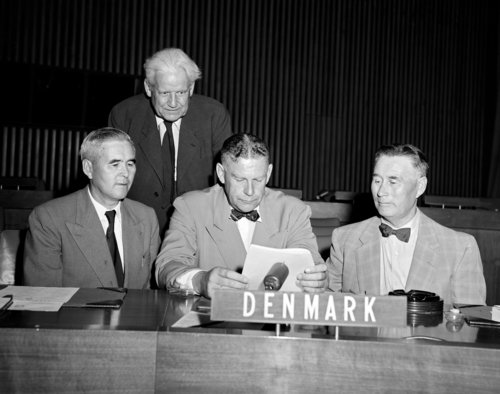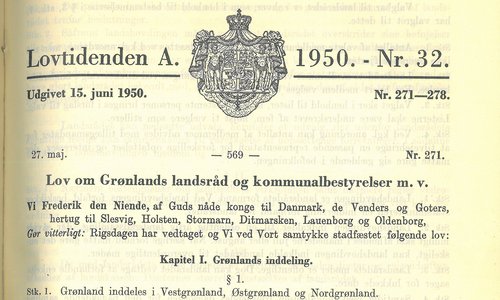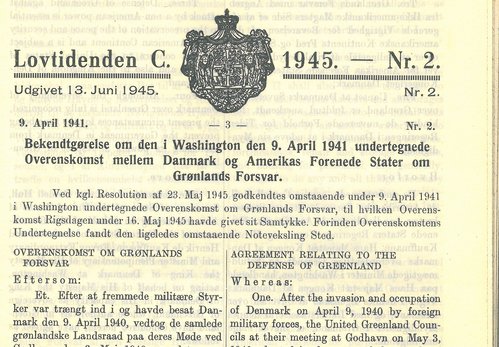The Danish decolonisation of Greenland, 1945-54
An international discussion on decolonisation followed in the aftermath of the Second World War in the mid-1940s. The newly formed United Nations created some of the most important platforms for these discussions. Consequently, Danish politicians and civil servants feared that Greenland, the last of the Danish colonies, would attract negative international attention. Greenland had joined the Danish colonial empire when the missionary Hans Egede (1686-1758) began colonisation in 1721. Denmark governed Greenland as a colony for the following two centuries. From 1945 to 1954, the question of Greenland’s colonial status formed one of the most important aspects with respect to Danish ambitions in the UN. Denmark conducted a series of meetings and sat on several committees in order to influence the international community to accept a continued Danish presence in Greenland. It succeeded. When the Danish electorate voted for changes to the Danish constitution in 1953, Denmark simultaneously integrated Greenland as a county. The UN recognised Greenland’s new status in 1954.

* Listen to this article as a podcast in English or Danish by clicking here.
Greenland in the era of decolonisation
Denmark ratified the Charter of the United Nations in 1945. The Charter’s focus on colonial conduct and governance urged its signatories to improve conditions in their respective colonies – provided they possessed such territories. As the anti-colonial United States of America and the Soviet Union emerged victorious in the Second World War, they strived to define and make anti-colonial policies the order of the day. In 1946, the United Nations asked all member states, including Denmark, whether they possessed one or more colonies. If Denmark acknowledged possessing a colonial territory, the Charter obliged Denmark to submit statements and reports on the territory to the United Nations.
Although Denmark had governed Greenland as a colony, Danish civil servants and politicians were reluctant to see Greenland as on a par with other colonial territories. They argued that, as Denmark had never exploited Greenland as other European powers had done in Africa or Asia, the Charter did not apply to Greenland. Ultimately, however, Denmark did choose to report Greenland as a Danish colony. After all, it was better to influence global opinion at the new centre of international cooperation. Firstly, Greenland’s geostrategic position as an enormous buffer zone between the United States and the Soviet Union strengthened Denmark’s opportunity for advancing its interests. Secondly, the Danish government did not think that its form of colonial rule would attract as much negative attention as the colonial regimes in Africa and Asia. All of this increased the likelihood that Denmark could be framed as a benevolent colonial power, which in turn could translate into international recognition of a continued Danish presence in Greenland. Because of these considerations, Denmark reported that Greenland was a colony. Thereafter, Danish uncertainty about Greenland’s future status grew as anti-colonial sentiments increased in the following years.
The modernisation of Greenland
In order to modernise the conditions in Greenland – in line with the UN Charter – the Danish government appointed a commission in 1948. Two years later, the commission presented a modernisation scheme to reform the economic, political, and social fabric of Greenlandic society, which subsequently became law. The Greenland Acts of 1950 paved the way for radical changes to Greenlandic society from the 1950s onwards.
Global opinion was increasingly on a collision course with colonialism in the late 1940s and early 1950s. The United Nations continued its work to organise committees to discuss as well as monitor colonial administrations. The Danish government designed the Greenland Acts of 1950 to demonstrate its capacity and willingness to modernise its colony and improve the lives of its 20,000 inhabitants. It was easier to modernise a less populated colony such as Greenland than the densely populated colonies of Africa and Asia. Denmark exploited this opportunity to frame its performance as a colonial power even more favourably. Moreover, the Greenland Acts of 1950 buttressed the perception of Denmark as a benevolent colonial power to both the Western and Eastern blocs of the Cold War. This was to yield favourable prospects in international negotiations.

The Greenland Provincial Council Act originated from the 1948 commission’s work. The law created a unified legislative body in Greenland. Two provincial councils in Greenland, a northern and a southern council, existed prior to 1950 and, as they had been unified during the Second World War, a precedent had been created for a unified Greenland Provincial Council. Excerpt from the official record of Danish laws, Lovtidende A 1950.
Denmark as a benevolent colonial power
The perception of Denmark as a benevolent colonial power allowed Danish diplomats and politicians to bridge some of the gaps of the Cold War. The United States and the Soviet Union agreed on Denmark being the most benevolent of the colonial powers - an excellent opportunity to exploit international goodwill in order to safeguard Greenland as a Danish territory.
In the early 1950s, the United Nations sought to create a list of factors to determine when a colonial territory reached equality in relation to the mother country. Whenever a mother country met one of the factors, the United Nations would debate and possibly repeal the territory’s colonial status. Members of the United Nations continuously negotiated the contents of the list of factors. When the colonial status of Greenland was put to the vote, three factors were valid. The international community no longer considered a territory to be a colony when it achieved independence from, free association with, or full integration into the mother country. Before the revision of the Danish constitution in 1953, the Danish government proposed ‘integration’ as an eligible factor as well. The United Nations approved and added this factor to its list of factors. This proved decisive in the upcoming negotiations on Greenland’s territorial status.
Neither the Soviet Union nor the United States of America had an interest in promoting Greenland’s independence. As its geopolitical position maintained a buffer zone between the two, Greenland becoming a new country risked provoking an undesirable chain of events in the Arctic. Most likely, the United States, thanks to its active military bases in Greenland, would fill the power vacuum created by a Danish withdrawal. A new and untested US-Soviet frontier could cause conflict. Because of this, the United States and Soviet Union accommodated Danish views and perspectives. The United States particularly kept a friendly disposition towards Denmark at this time. This was largely because, in 1941, the wartime ambassador of Denmark to the United States, Henrik Kauffmann (1888-1963), permitted the American government to construct military bases in Greenland without first consulting the German-influenced government in Copenhagen. In return, Denmark received much more American goodwill than its size merited.
American goodwill, geopolitical considerations, and positive perceptions of Danish colonial rule increased the prospect of preserving Greenland as a Danish territory. Additionally, when the United States had acquired the Danish West Indies (the US Virgin Islands) in 1917, the Americans had wholly acknowledged Greenland as a Danish territory. The American government had even proposed to buy Greenland in 1946, thus implicitly honouring the agreement of 1917 and recognising Danish sovereignty. All of this eased a future integration of Greenland into Denmark.

The agreement that permitted the United States of America to build military bases in Greenland. Ambassador Henrik Kauffmann, who acted independently from the German-influenced Danish government in Copenhagen, signed the agreement on April 9, 1941. In occupied Denmark, the agreement caused an uproar. The Danish government recalled Kauffmann, but he continued his work as an independent Danish diplomat to Washington for the duration of the war. In the aftermath of the Second World War, the Danish houses of parliament (Rigsdag) unanimously passed the 1941 agreement. Excerpt from from the official record of Danish laws, Lovtidende C, 1945, no. 2.
Greenland's new status
As anti-colonial sentiments grew and the heated decolonisation debate turned ally against ally, Denmark was conveniently enough preparing a revision of its constitution.
Great Britain and France joined each other in defending imperial interests against American and Soviet pressure. Simultaneously, Danish politicians and civil servants proposed that the constitutional revision could also include the integration of Greenland into Denmark as a county. The Danish government presented the Greenland Provincial Council, the Landsråd, with the proposal in 1952, which they approved after a few days of deliberation. When the revised constitution passed into law after a referendum in 1953, it stated that it “applies to all parts of the Kingdom of Denmark.” This importantly included both Greenland and the Faroe Islands. The Greenlandic electorate did not participate in the referendum, and the Danish government merely consulted the Greenlanders through their elected representatives in the Greenland Provincial Council. The revised constitution made Greenland a county; the revision also guaranteed two seats in parliament for Greenland, which wielded substantial power relative to the small size of the Greenlandic electorate. The modernisation scheme and representation in parliament were convincing signs of integration and decolonisation.
In 1954, the United Nations voted on whether to accept or reject Greenland’s new status. The vote passed thanks to Denmark’s reputation as a benevolent colonial power. Danish willingness to modernise Greenland, the revised constitution that guaranteed suitable Greenlandic representation in parliament, and the Danish addition of ‘integration’ to the UN’s list of factors all contributed to the vote being carried. The newly elected Greenlandic members of the Danish parliament, Augo Lynge (1899-1959) and Frederik Lynge (1889-1957), gave talks on Greenland’s status to the United Nations before the vote. It all looked convincing to the international community. From 1954, the United Nations no longer perceived Greenland to be a colony. Denmark preserved a significant territory at a time when most European colonies were declaring independence. Greenland was a Danish county until 1979 when it attained home rule.
Further reading:
- Erik Beukel et al, Phasing out the Colonial Status of Greenland, 1945-54 (Copenhagen; Museum Tusuculanums Forlag, 2010).
- Simon Mølholm Olesen, ’Et helligt hverv: Grønlands afkolonisering, 1945-54’ [A sacred trust: Greenland's decolonization], Temp – tidsskrift for historie, 13, (2016), pp. 152-176.
- Stanley Meisler, United Nations: A History (New York; Grove Press, 2011).
Links:
- Thanks go to danmarkshistorien.dk for allowing us to translate this article. Read this article in Danish on danmarkshistorien.dk.